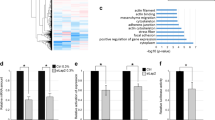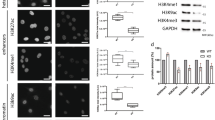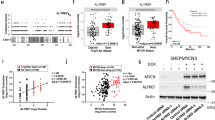Abstract
The chromosomal inversion 16(p13;q22) associated with human acute myeloid leukemia generates the chimeric PEBP2β /CBFβ -SMMHC gene. The PEBP2β/CBFβ portion of the chimeric polypeptide harbors most of the amino acid sequence of the PEBP2β/CBFβ protein, the non-DNA binding subunit of the heterodimeric transcription factor, PEBP2/CBF, whereas the SMMHC portion of the chimera consists of the rod domain of the smooth muscle myosin heavy chain molecule. In this study we examined the subcellular localization of the chimeric protein and its effect both on stress fibers and transcriptional activation by transfecting cDNA into tissue culture cells. The localization of the chimera was investigated by immunocytochemical staining of cells and was found to be both cytoplasmic and nuclear. One aspect of the effect of expression of the chimera was a drastic alteration of cell morphology. The cells appeared elongated and possessed long cytoplasmic processes. Double fluorescent labeling revealed disorganization of the stress fibers and an altered F-actin staining pattern in the transfected cells. Studies using a deletion mutant showed that both the PEBP2β/CBFβ and SMMHC domains are necessary for the induction of the morphological alteration. A significant proportion of the chimeric protein was retained in the cytoskeleton after detergent extraction of the cells and could be recuperated as a membrane fraction, suggesting that this is one of the probable sites of action of the PEBP2β/CBFβ-SMMHC protein. Another effect of the chimeric protein was inhibition of transcriptional activation dependent on the PEBP2/CBF binding DNA sequence. However, deregulation of PEBP2/CBF site dependent transcription by itself was not sufficient to induce cell morphological changes. Taken together, these results indicate that the PEBP2β/CBFβ-SMMHC chimeric protein acts at two levels, at the level of stress fiber organization and at the level of transcriptional activation. We suggest that the action of PEBP2β/CBFβ-SMMHC depends to a great extent on whether it is located in the cytoplasm or in the nucleus.
This is a preview of subscription content, access via your institution
Access options
Subscribe to this journal
Receive 50 print issues and online access
$259.00 per year
only $5.18 per issue
Buy this article
- Purchase on Springer Link
- Instant access to full article PDF
Prices may be subject to local taxes which are calculated during checkout
Similar content being viewed by others
Author information
Authors and Affiliations
Rights and permissions
About this article
Cite this article
Tanaka, Y., Fujii, M., Hayashi, K. et al. The chimeric protein, PEBP2β/CBFβ-SMMHC, disorganizes cytoplasmic stress fibers and inhibits transcriptional activation. Oncogene 17, 699–708 (1998). https://doi.org/10.1038/sj.onc.1201985
Received:
Revised:
Accepted:
Published:
Issue Date:
DOI: https://doi.org/10.1038/sj.onc.1201985
Keywords
This article is cited by
-
The PEBP2β/CBFβ-SMMHC chimeric protein is localized both in the cell membrane and nuclear subfractions of leukemic cells carrying chromosomal inversion 16
Leukemia (2000)
-
Exogenous cdk4 overcomes reducedcdk4 RNA and inhibition of G1 progression in hematopoietic cells expressing a dominant-negative CBF – a model for overcoming inhibition of proliferation by CBF oncoproteins
Oncogene (2000)
-
Indispensable role of the transcription factor PEBP2/CBF in angiogenic activity of a murine endothelial cell MSS31
Oncogene (2000)



